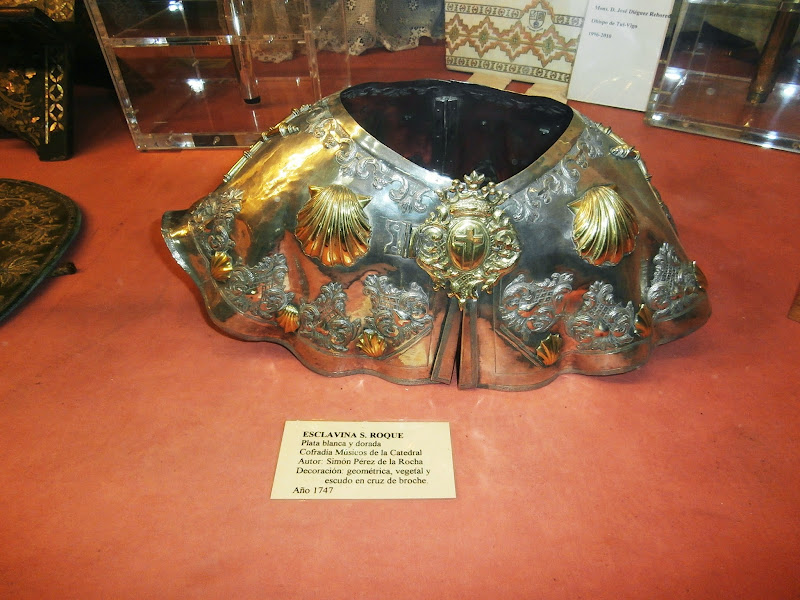The Cathedral Museum is divided into three parts: the Chapel of Santa Catalina, the Cloister and the Chapter House.
The Chapel of Santa Catalina:
It is located beside the right aisle of the Cathedral. It is Gothic (14th century) but it was entirely transformed in the 17th and 18th centuries. The Cathedral Treasure is guarded in the Chapel of Santa Catalina.
The reliquary called Copón de Coco, the statue of the Virgin and Child “la Patrona”, the complete red three-piece suit (16th century), the silver amphorae of the Holy Oils, Processional Monstrance (1602), the statue of Saint Anne, Madonna and Child (1520), the Ship of San Telmo, Baroque altarpieces stand out among the valuable treasures that the Cathedral Museum contains.
The statue of the Virgen del Pilar is made of silver.
Teca with skeletal remains of the Apostle Saint Bartholomew (a teca is a small box in which a relic is kept). It belongs to the parish of San Bartolomé de Rebordáns, near Tui. Provenance: Monastery of Santa María de Oia. The reliquary is silver filigree (18th century).
From left to right: Gold and silver Monstrance (18th century), a key of a sacrarium, a casket made of silver and wood (18th century), a silver baton of a master of ceremonies (18th century), botafumeiro made of silver (18th century), three crowns made of silver (the two most right are of 1780).
Diurnal missal (17th century), a silver baton of a chapel maestro (made of silver and wood).
A choir book (17th century).
Sacras (made of chiselling silver, motif of San Telmo), Ship of San Telmo (made of silver and precious stones, 18th century), Medallion of San Telmo (made of silver, 19th century).
Ship of San Telmo (made of silver and precious stones, 18th century), Medallion of San Telmo (made of silver, 19th century).
Child Jesus. Carving and niche are made of polychrome wood. 1756.
These are chalices of different historical periods.
Virgen del Pilar (carving and niche are made of polychrome wood, it has a silver crown with a precious stone, 1780).
From right to left: Pellegrina (http://en.wikipedia.org/wiki/Pellegrina) of San Roque (made of white and golden silver, 1747), mitre and staff of Monsignor D. José Diéguez Reboredo, Medallion of San Roque (1747), a lectern made of wood and mother-of-pearl (from Japan), naveta (small ship, made of silver, 17th century), a lectern (made of white and golden silver), aguamanil (water pitcher, made of silver), the Virgin and Child “la Patrona” (Gothic carving, 14th and 15th centuries, paint of 1643), embroidered chasubles of different periods, the silver amphorae of the Holy Oils (1790).
The Virgin and Child “la Patrona” (Gothic carving, 14th and 15th centuries, paint of 1643).
Pellegrina (http://en.wikipedia.org/wiki/Pellegrina) of San Roque (made of white and golden silver, 1747).
Silver amphorae of the Holy Oils (1790).
Baroque altarpiece.
The oil painting that represents San Francisco Javier. It was donated in 1618. It is the oldest iconographic representation of the Saint who was beatified in 1619 and canonized in 1622.
Baroque altarpiece.
























No comments:
Post a Comment